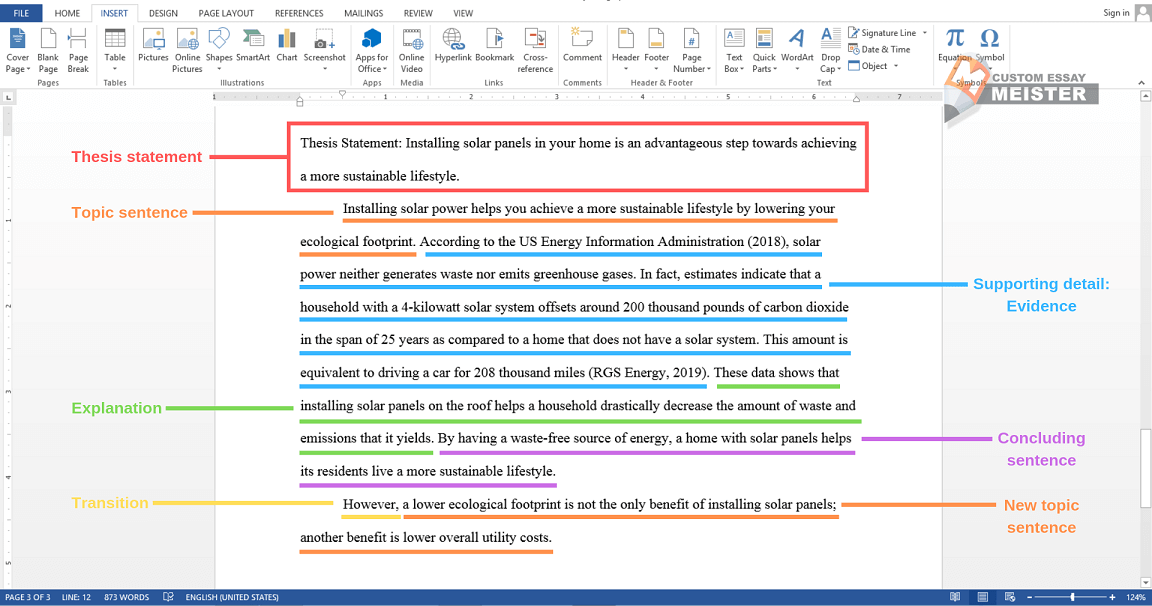How to Write a Body Paragraph
Every student knows that a good paper has three major parts: the introduction, the body, and the conclusion . While writing the introduction and the conclusion may seem easy because of their relative shortness, writing a body paragraph is an entirely different story. After all, filling pages and pages of content for your paper can be a daunting challenge. But writing body paragraphs does not have to be too complicated. Learning the basics of the body paragraphs such as its purpose and its components can help you write better papers.
Purpose of the Main Body and the Body Paragraph
The principal purpose of the main body is to expound on your thesis statement . You may recall that the thesis statement is the main claim of your paper: it is the main idea you are trying to communicate. Whereas the thesis is the claim, the body of your paper is where you defend your thesis through a variety of ways. Remember that a paper can take many different forms, and thus the content of the main body varies. For instance, if you are writing an argumentative paper, the main body will likely present your arguments, evidence supporting these arguments, reasoning, counterarguments, refutations to the counterarguments, and any other relevant parts. But if you are writing a literary analysis, your main body will likely feature summaries, narratives, quotes, and analysis. Regardless of the type of your paper, one thing is true: your main body should work towards defending your thesis. The main body is therefore the meat of your paper.
If the main body’s purpose is to expound your thesis statement, the individual body paragraph is to present a specific argument, idea, or topic related to the thesis and then prove, defend, or explain it. A good body paragraph is one that ultimately contributes to the goal of the paper.
Parts of a Body Paragraph
There are no absolute rules for writing a body paragraph, and individual approaches to writing a paper can yield paragraphs of various forms. What is important is for a paragraph to be clear, cohesive, and effective in contributing to the goal of the paper. In academic writing, however, paragraphs tend to follow a basic essay structure that features three main parts: topic sentence, supporting details, and concluding sentence.
- Topic Sentence. The topic sentence presents the idea of the body paragraph. It is the topic that the specific paragraph discusses. Although the topic sentence can be placed anywhere, it is best placed in the beginning of the paragraph, since this immediately informs the reader of what the paragraph will discuss. This will save the reader the trouble of figuring out what the paragraph is about.
- Supporting Details. As the term itself indicates, supporting details are the information you present to support your topic sentence. Supporting details come in different forms, but they usually feature evidence along with analysis or explanation. For instance, if the topic sentence is about how installing solar panels helps you lower your carbon footprint, your supporting details should provide data comparing the carbon footprints of a house with solar panels and a house without solar panels. Then you should explain the significance of the data and their connection to the thesis, rather than leave them standing on their own.
- Concluding Sentence. The concluding sentence is often the last part of the body paragraph. It is usually added to summarize the entire paragraph. This part, however, is not considered as necessary. Furthermore, a concluding sentence may sometimes sound stilted, and thus you should assess first whether it should be added or not.
Additional Parts: Transitions. The purpose of transitions is to improve the flow of your paper by serving as connections between different parts. For example, transitions may introduce a new idea or topic, provide examples, or conclude. Transitions are not always necessary, but effective use of these can improve your paper.
To better illustrate how the body paragraph should be written, take a look at the sample below:
In the sample provided above, notice how each of the parts contributes to the body paragraph.
- The topic sentence directly relates supports the thesis statement by arguing how a lower ecological footprint due to the solar panels contributes to a more sustainable lifestyle.
- Then, the evidence presents concrete data that proves the topic sentence. Meanwhile, the explanation expounds why the data is significant.
- Finally, the concluding sentence summarizes the paragraph.
- In the next paragraph, the transition links the previous idea with the new topic sentence.
In the end, body paragraphs can definitely be written in different ways. More creative approaches to writing may result in body paragraphs that deviate from the basic structure. However, learning the fundamentals of writing a body paragraph is the first step towards better writing.